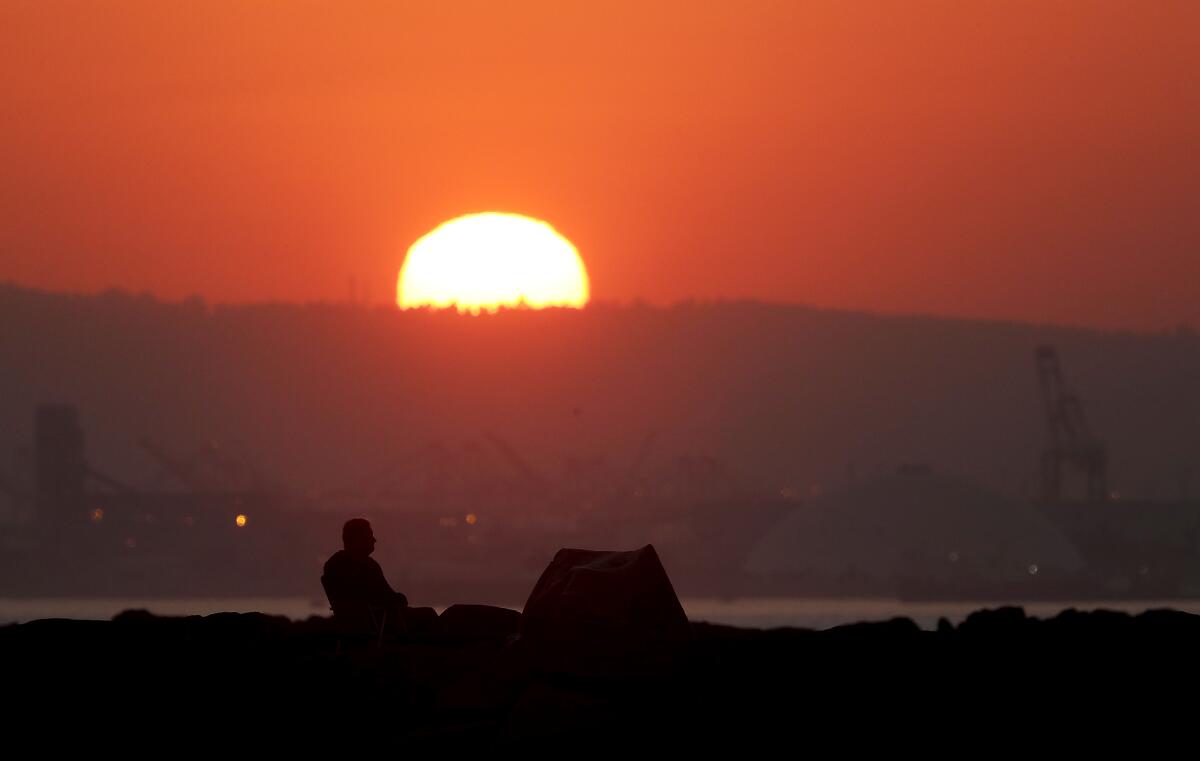Intense heat wave breaks numerous records, fuels dangerous fires across California

- Share via
An intense heat wave broiled large swaths of California this Labor Day weekend, shattering numerous records, causing thousands to lose power and fueling several brush fires that were threatening communities from Yucaipa to the Sierra foothills.
Forecasters had predicted historic high temperatures, and they were proved right. Dozens of communities set records Saturday, and a few appeared to record all-time highs, according to the National Weather Service.
In Woodland Hills, the mercury climbed to 117 degrees by 3 p.m., making it the hottest day ever recorded there in September, breaking the record of 115 set in 1979. Burbank reached 113, tying its monthly record set in 1971. Van Nuys hit 115.
The mercury soared even higher to the east, with Palm Springs hitting 122 and Indio 121. Officials said at least three areas tied or topped all-time record highs: Alpine (113), El Cajon (114) and Idyllwild (103). The weather service said Burbank appeared to tie an all-time record at 114 degrees.
The temperatures were expected to climb even higher in some places on Sunday, reaching 119 degrees in Woodland Hills, 114 in Pasadena and 110 in Simi Valley, said David Sweet, a meteorologist with the National Weather Service in Oxnard.
“Some of these temperatures could be the all-time record for the location,” Sweet said.
The heat, combined with bone-dry conditions, helped several huge fires explode out of control Saturday, with firefighters struggling to keep up.
A brush fire in the Sierra National Forest exploded Saturday, consuming more than 36,000 acres, threatening local communities and trapping 150 people near a popular reservoir.
The fast-moving Creek fire cut off evacuation routes to Mammoth Pool Reservoir, according to the Madera County sheriff’s office. All of the people were reported safe but 10 of them suffered some type of injury, the sheriff’s office said.
The California National Guard assisted in a major rescue operation Saturday night, using a CH-47 Chinook helicopter to help airlift people trapped by the fire, including some who are injured, said Gen. Daniel Hokanson, chief of the National Guard Bureau. Hokanson said in a tweet that people had been taken to CalGuard facilities and were met by medics and civilian first responders.
The Fresno Fire Department said late Saturday that several military helicopters had rescued 63 people and taken them to Fresno Yosemite International Airport . Injuries were severe for two people and moderate for 10 others, while 51 people had minor or no injuries, fire officials said in a tweet. Aircraft were returning to continue operations but it was unclear, the tweet said, how many more people needed to be evacuated.
Sierra National Forest spokesman Dan Tune said those trapped in the reservoir area were not in imminent danger since the fire front has moved past them and was headed north. But people have been advised to shelter in place while strike teams of engines and hand crews try to clear evacuation routes and contain the fast-moving flames. The fire is also threatening a range of structures and power lines.
“The priority right now is community and life safety,” he said.
Residents of Huntington Lake, Camp Sierra and Big Creek in Central California were ordered to evacuate.
Near Yucaipa, another fire had burned more than 1,500 acres and forced evacuations in numerous mountainside communities in San Bernardino County. Dubbed the El Dorado fire, the blaze began about 10:30 a.m. in the 37000 block of Oak Glen Road, forcing the evacuation of Oak Glen, Forest Falls, Mountain Home Village and parts of eastern Yucaipa.
The blaze also closed a portion of the San Gorgonio Wilderness, according to San Bernardino National Forest officials.
In San Diego County, a 1,500-acre fire in the rural Japatul Valley area threatened homes and forced evacuations.
The new blazes came as 12,400 firefighters continued to fight 22 large fires that have together scorched more than 1.5 million acres since they were sparked by a series of dry lightning strikes last month.
The National Weather Service has issued a red-flag warning, which indicates critical fire weather conditions, for the valleys and mountains of Southern California that will be in effect from 6 p.m. Sunday to 10 p.m. Monday, Sweet said.
In Santa Barbara County, a red-flag warning is in effect for the mountains and South Coast from 6 p.m. Saturday through 10 p.m. Monday because of the heat, low humidity and gusty “sundowner” winds, forecasters said.
The forecast prompted Gov. Gavin Newsom to issue an emergency proclamation aimed at shoring up California’s energy capacity and staving off the kind of power outages and rolling blackouts that left tens of thousands of residents in the dark during the last big heat wave.
The California Independent System Operator, which runs the power grid for most of the state, has issued a statewide flex alert — calling for residents to voluntarily cut back their electricity consumption from 3 to 9 p.m. Saturday through Monday.
Southern California Edison reported about three dozen outages spread out over the region Saturday afternoon. They ranged in size from one or two customers to more than 1,900, according to the utility’s website.
Los Angeles Department of Water and Power spokesman Joe Ramallo said that utility’s crews were dealing with a handful of outages Saturday afternoon, but that only 550 of its 1.5 million customers citywide were affected.
“Our crews are working as fast as they can under extreme temperatures,” he said. “Our system is holding up very well right now.”
September heat waves are nothing new for Southern California, said climatologist Bill Patzert. But they’ve become hotter, longer-lasting and more frequent, a trend that’s all but certain to persist, he said.
“This is definitely a trailer of the feature,” he said.
Over the last century, the average temperature in Los Angeles over the entire year has increased by about 5 degrees, Patzert said. But the average temperature for the months of August and September has increased by 8 to 9 degrees, he said.
“That’s not warming up, that’s heating up,” he said.
He attributes the rise to a combination of a slow increase in global temperatures and a faster heating of Southern California due to the buildup of heat-absorbing infrastructure, with a population that’s quadrupled since the 1950s.
“We created this great megalopolis from the San Fernando Valley to the Inland Empire to the ocean, and what we’ve done is cram 20 million people into it, and we’ve created an awful lot of infrastructure that tends to absorb the heat,” he said. “So not only are we living in a warmer world due to global heating, we’re creating our own heat.”
On top of that, he said, while one- to two-day heat waves were the norm in the middle of the century, “now we see one-week heat waves.” And they’re hotter, as evidenced by the falling records.
“You never read very much about low temperature records, they’re, like, in the rearview mirror,” Patzert said. “Whenever there’s a record, it’s always a new high.”
The triple-digit temperatures coincide with Labor Day weekend, which is typically one of the busiest beach days of the summer even absent a record-breaking heat wave.
At 9:30 a.m Saturday, hundreds of beachgoers dotted the shore in Marina del Rey. Despite the morning hour, parking spots were hard to find, forcing families to walk multiple blocks, all while carrying plastic buckets, beach towels and umbrellas.
Boaters and kayakers zipped along the water, while several games of beach volleyball were underway.
In the parking lot of the San Gabriel Mission, where temperatures hit 106 degrees around 1:30 p.m., dedication was tested, but healing services and rituals were ultimately performed.
About 70 family and friends of parishioner Magdalena Lopez, who died on Aug. 14 at the age of 65, gathered to honor her in a socially distanced outdoor funeral held under three giant white canopies.
Thirty-year church musician Ralph Mohutsky Jr. said he was “concerned” about the extreme heat before leaving his Alhambra home, but he didn’t hesitate to play that afternoon.
“The sense of duty of wanting to give a family peace and closure overrode my fear of overheating,” Mohutsky Jr., 54, said. “I made sure to prepare as best as I could to be outside.”
The heat was doubly concerning for Los Angeles resident Isabel Romero, who runs a white-dove release business specifically catering to funerals.
She arrived at the one-hour service shortly before its conclusion with two crates of 20 birds.
The doves were handed to family members after the service. The group of mourners formed a circle and jointly released the birds into the air. The trained doves circled around the canopies and adjoining cemetery and mission en route to the company’s coop in Montebello.
“I really hope they all make it back,” said Romero, 46, who has been running the business with her husband, Manuel, for 20 years. “In extreme weather like heavy rain or heat, sometimes they all don’t make it back.”
In the Mojave Desert town of Baker, home to the world’s tallest thermometer, the temperature ticked up from 117 to 118 degrees just after 2 p.m.
Miles down the road, northbound traffic on Interstate 15 was slowed to a crawl as firefighters extinguished a burning car.
Times staff writers Joseph Serna, Kevin Rector, Dakota Smith and Luke Money contributed to this report.
More to Read
Sign up for Essential California
The most important California stories and recommendations in your inbox every morning.
You may occasionally receive promotional content from the Los Angeles Times.

















